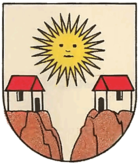Lichtental (Vienna)
| Lichtental | |
|---|---|
| coat of arms | map |
 |

|
Lichtental was an independent municipality ( suburb ) until 1850 and is now a district of Vienna in the 9th district of Alsergrund .
geography
Lichtental lies in the north of the Alsergrund and is completely enclosed by parts of the Alsergrund district. In the east Lichtental borders on the Althangrund , in the north and south on the Thurygrund and in the west on the Himmelpfortgrund . The current borders to the other parts of the Alsergrund district run along Fechtergasse , Liechtensteinstraße to the border O.-Nr. 113 and 115 (today in the Bausparkasse building from no. 111–115), Nussdorfer Strasse between O no. 66 and 68, Rufgasse and Althanstraße .
Lichtental-Spittelau is a counting district of the official statistics consisting of eight counting districts, which also includes parts of the surrounding former suburbs.
history
The area was first mentioned in a document in 1280 as "Lichtenwerd". The name "Werd" referred to the location on an island between the Danube Canal and a now silted arm of the Danube in the area of today's Liechtensteinstrasse, since "werd" was the Middle High German name for island. The existing second part of the name Lichtental comes from a field name that has been known as Talwiese for centuries .
Lichtental originally belonged to the Roßau. Johann Adam Andreas Fürst Liechtenstein acquired meadows in Roßau in 1687 together with the Auersperg'schen Garten . In 1694, the prince began building a brewery on the acquired property between Liechtensteinstrasse and Althanstrasse. In 1699 the remaining part was released for parceling. The Freigrund was subsequently also called Liechtenstein Valley , but also Liechtental , while the residents preferred the term “Auf der Wiesen” for a long time. The name "Karlstadt", which the prince had planned in honor of the emperor , however, could not establish itself.
The planned settlement was built on the Prater terrace, but extended over the old Danube bank slope to Nussdorfer Straße on the city terrace. The first brick building to be completed was the shoemaker Johann Friedrich Riess' house at Salzergasse 38, which was given the name of the Golden Key . In 1701 there were already 14 houses on the former meadow. 23 more followed by 1720, 42 additional ones by 1730 and finally 95 houses in 1740. The settlement initially took place in a scattered position, which suggests the assumption that the entire building site was already marked out and the settlers were free to choose their building site. As early as 1730, the settlement extended over the entire area.
The rapid settlement also made it necessary to build a church, as services had to be held in the brewery for the time being. The construction of the Lichtentaler parish church ( for the 14 Holy Helpers , also Schubert Church ) began as early as 1712 and was completed in 1718. In 1723 the parish was founded by separating the church from the parish in the Währing parish church , and in 1730 the church was consecrated. However, the growth of the parish area led to an expansion of the church as early as 1769 to 1773.
The hospitality industry played a major role in the town, since 20 houses, i.e. ten percent of the total stock, housed restaurants.
With the abolition of the manorial rule in 1848, Lichtental fell to the City of Vienna. In 1850 Lichtental was incorporated into the newly formed Alsergrund district and incorporated into Vienna.
Personalities
- Matthäus Mederer Edler von Wuthwehr (1739–1805), professor of surgery
- Catarina Cavalieri (1755–1801), singer
- Johann Baptist Drechsler (1756–1811), painter
- Franz Seraphicus Schmid (1764–1843), Roman Catholic clergyman, was the confessor of Empress Karoline Auguste
- Josef Moser (1779–1863), pharmacist and pioneer of gas lighting
- Moritz Daffinger (1790–1849), painter
- Franz Xaver Petter (1791–1866), painter
literature
- Alfred Wolf: Alsergrund. District of Poets and Thinkers. Mohl, Vienna 1993, ISBN 3-900272-48-4
Web links
Coordinates: 48 ° 14 ' N , 16 ° 21' E


